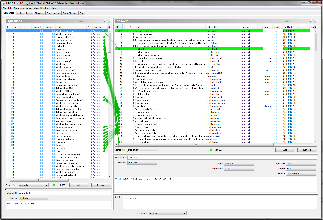Page History
...
The quickest way to make a character speak a line is to double click an entry in the right side of the Utterances Tab, under "Answers". The character should speak the line you've selected, with lip sync and gestures.
Where can I find all of Brad's
...
dialog?
NPCEditor has a series of tabs, each representing a different facet of the overall program. The All of Brad's, or any character's lines of dialog are stored in a plist generated by NPCEditor. NPCEditor uses a tabbed layout, with the two main tabs for users are being the Utterances Tab and the Chat Tab. Dialog is found in the Utterances Tab.
Utterances Tab
The left hand side of the Utterances tab lists the Questions, while the right is dedicated to the Answers. Questions are examples of user utterances that the system expects to receive. This can include questions, "What is your name?", and or statements, "Tell me about yourself." When NPCEditor receives user input, whether typed or spoken through AcquireSpeech, it uses a statistical classifier to compare the input to known Questions. If there is an exact match, NPCEditor automatically matches the two stringsresponds with the highest scoring Answer. If there is not an exact match, the classifier determines the closest line in the Questions tab and responds with the highest scored linked Answer. These scores are determined by the links between Questions and Answers.
Character dialog is listed as Answers on the right of the tab. Each of a character's lines of dialog has its own entry. An Answer consists of a number of fields. External ID is the file name of the sound file to be played back with a line of dialog. Text is the transcript of the line. Domain is used to control different dialog phases. Speaker and Addressee designate which character speaks this line and who is listening, whether another character of the user. Type is used to denote specific types of dialog, such as control lines, for example when Brad cannot understand the user's question. Topic and Sound are used to sort the dialog. Each of these fields and the values within can be edited in the Settings Tab.
Can I talk to a character inside NPCEditor?
...
The Chat Tab allows you to see a log of the latest discussion with an NPCEditor controlled character, and interact with a character independent of other tools. You don't need a renderer or any other components. The body of the tab is by default a maximized chat interface. Users may enter what they wish to say to a character at the bottom, and the classifier will select the best response and print it to the Conversation Log. For example, as you speak to Brad with your microphone, you will see your speech and Brad's responses populate the log. If you wish to type an answer, you may do so here by selecting the user to speak as, typing your utterance, then pressing clicking "Enter Question" in the bottom right. If Unity or another engine is running, Brad should speak and respond there, as well as in his window. Even without any other components running, you can test text interaction with a character through this interface.
...
